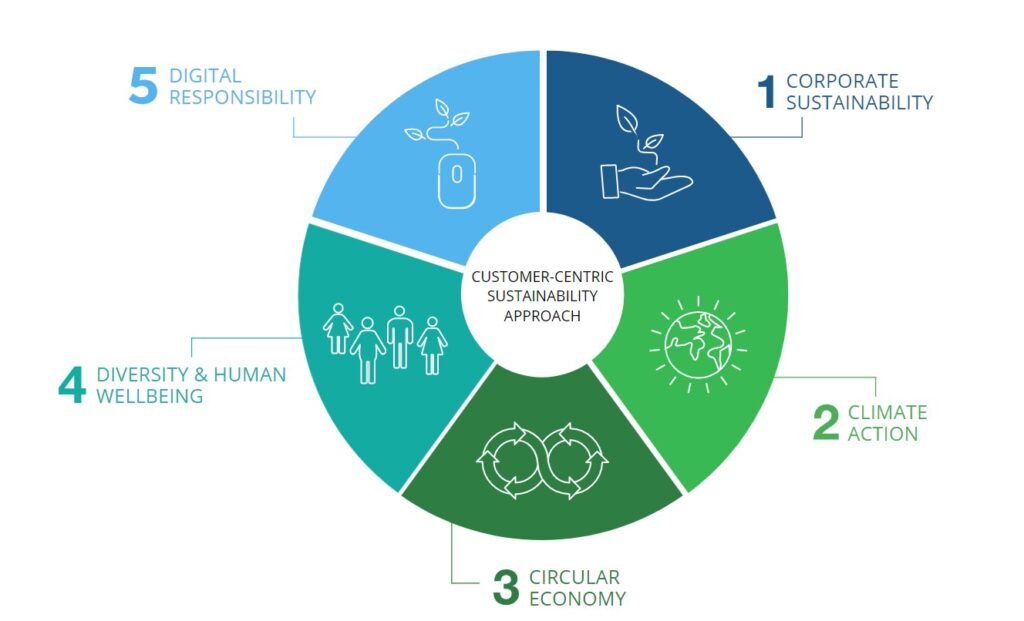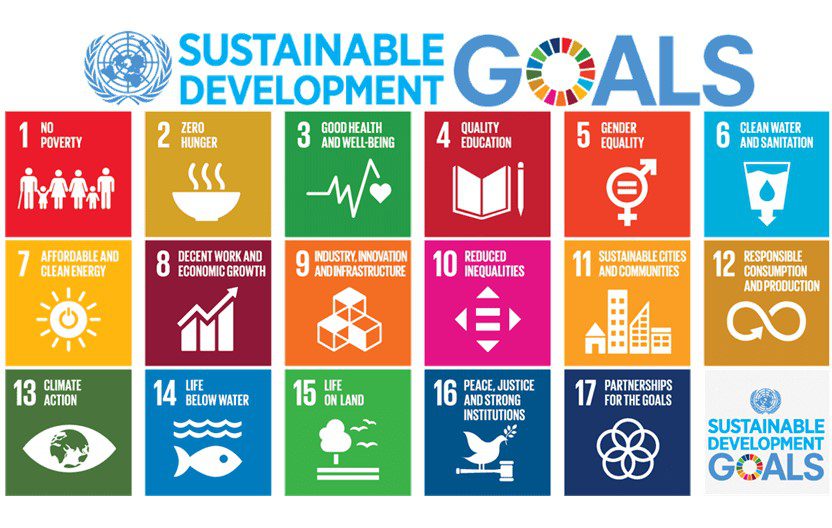
Sustainability : Konica Minolta’s EU Approach
Konica Minolta receives the highest level in EcoVadis Sustainability ratings and is selected for the leaderboard of CDP’s supplier engagement rating

Konica Minolta, Inc. (Konica Minolta) has been awarded the GOLD Level Recognition Medal in the 2023 EcoVadis sustainability ratings, placing the company among the top 5% of firms in its industry. This recognition is a testament to Konica Minolta’s unwavering dedication to sustainability and corporate responsibility. The rating process evaluates each participating company through scorecards that encompass 21 CSR indicators, 190 commodities, and 150 countries. The evaluation framework draws on the Global Reporting Initiative, the United Nations Global Compact, and the ISO 26000, which consider the environment, social factors, ethics, and supply chain.
About the EcoVadis sustainability report
EcoVadis operates an international platform to assess the corporate social responsibility (CSR) of suppliers in terms of the environment, labour practices, ethics and sustainable procurement. The rating process is based on scorecards for each participating company that cover 21 CSR indicators, 190 commodities and 150 countries. The evaluation environment is built on the Global Reporting Initiative, the United Nations Global Compact and the ISO 26000, which take environment, social, ethics and supply chain into account.

About the Leaderboard of CDP’s Supplier Engagement Rating
In addition to its excellent EcoVadis Sustainability rating, Konica Minolta has been recognised for its supplier engagement efforts, earning a place on the 2022 CDP Supplier Engagement Leaderboard in the Supplier Engagement Rating, along with 282 other companies. Additionally, Konica Minolta has achieved global leadership status on the Climate A List by CDP, for the seventh time. CDP is an international non-profit organisation working towards realising a sustainable economy.
Konica Minolta’s Green Supplier Activities
For several years, Konica Minolta has been promoting Green Supplier Activities to provide suppliers with the expertise to reduce their environmental impact while also reducing costs. This approach was derived from its own manufacturing sites within the Green Factory certification system. Many suppliers were already able to achieve their Green Supplier activity targets, which are equivalent to the level of the Green Factory Certification Standards. For example, Konica Minolta employees visited suppliers’ plants to conduct energy conservation diagnoses and help suppliers implement measures, increasingly using an energy-saving diagnostic tool based on the digitalised expertise of energy-saving experts to do so. Since fiscal year 2020, these activities have been further upgraded as the DX-Green Supplier Activities. Konica Minolta will work with many more suppliers to rapidly expand the efforts to reduce CO2 emissions and costs throughout the supply chain and to foster a system and culture that values environmental management.
Sustainability News: Counteracting global climate change
As part of the 50 Climate Leaders, Konica Minolta are acting as a community to combat global climate Change. Companies worldwide are realising their crucial role in achieving social and environmental goals, particularly in combating climate change.
As part of their sustainability strategy Konica Minolta participates in the 50 Climate Leaders. This initiative from the private sector united in order to show commitment to the economic landscape and to act as a community in counteracting global climate change.
In September 2020, Konica Minolta joined a summit of the 50 Climate Leaders, moderated by the United Nations. Participating in a group of ambitious companies creates a mutually encouraging environment and enables knowledge transfer on a global level, making a huge audience aware of the topic as well.
To tackle global sustainability challenges and bring benefits to its customers, Konica Minolta’s sustainability approach comprises five material topics.
1:- Corporate Sustainability
Konica Minolta has a clear commitment to sustainability with its Corporate Philosophy “The Creation of New Value”. This means that the company not only creates economic value but also social value through innovation – for the business and the people – and ultimately for a sustainable world.
Konica Minolta’s sustainable strategy entails the pursuit of Sustainable Development Goals (SDGs). The 17 Sustainable Development Goals of the United Nations are the world’s best plan to build a better world for people and our planet by 2030. They address the global challenges we face, like e.g. poverty, inequality, climate, biodiversity, peace and justice.
2:- Climate Action
Offsetting unavoidable CO2 emissions with the Enabling Carbon Neutrality program
With its Enabling Carbon Neutrality program, Konica Minolta offers its customers an all-in-one carbon emissions offsetting service for carbon neutral printing. This service provides office environments and providers of professional print products with an easy way to offset carbon emissions that occur during the printing process. To compensate for carbon emissions, Konica Minolta entered into a collaboration with the international climate protection expert ClimatePartner in 2015. So far, customers from eleven countries have already joined this effort, offsetting more than 10 million kilogrammes of CO2. Customers receive an emissions certificate stating the amount of CO2 emissions saved. The Enabling Carbon Neutrality program enables customers to meet their environmental targets: reducing their carbon footprint, demonstrating their commitment to climate protection and improving their corporate image.
3:- Circular Economy
Collect and recycle consumables
Konica Minolta is operating the “Clean Planet Program”. It entails a simple and yet sophisticated recycling solution for the consumables of its office and production printing systems in selected countries.
Konica Minolta’s office devices are built for long-life and have a recyclable design, a requirement of the strict environmental label “Blue Angel” that nearly all of its office devices have been awarded with. The devices will be reused after their first use-cycle for another four or five years and sometimes even longer.
Konica Minolta’s office and professional printing devices can be programmed specifically to ensure they use resources responsibly. So, customers benefit from reduced waste and improve their environmental impact.
4:- Diversity & Human Well-being
Clean air in the office: Indoor Air Quality
Konica Minolta is committed to actively improving the working environment of its customers and creating space for them to focus on their core competencies. As a measure of the cleanliness of air within offices and its potential impact on the personal health and comfort of those using the space, Indoor Air Quality is a service to improve the level of health and well-being overall. The company collaborates with a wide range of reliable and competent project partners to provide dedicated filter devices for different office systems, ensuring high emissions reduction while maintaining airflow in the devices involved. Filter solutions, measured by Blue Angel certifications, reduce copier particle emissions by up to 98%. Thus, customers can improve their indoor air quality, a key factor in the levels of health, comfort and productivity of staff.
The Standard Air Cleaning Unit
- Reduces emissions by ta least 90%
- Already standard in the latest Konica Minolta devices
The Optional Air Cleaning Unit
- Reduces emissions by between 82% and 97%
- Two different filters used for Konica Minolta devices
Find out more on Indoor Air Quality
5:- Digital Responsibility
We live in one of the most prosperous times in human history. At the same time, humanity faces massive challenges and changes due to digitilisation, because digitilisation changes the way we live and work. Climate change, massive pollution, dying species, migration are just some of our global sustainable challenges. But our changing environment and sustainable challenges can be influenced and shaped by us. Here, corporations play a central role. Konica Minolta acknowledges its responsibility and actively shapes it within its corporate digital responsibility.
Konica Minolta focuses on four key actions fields around corporate digital responsibility:
🖱 Data responsibility: Going beyond legal requirements
🖱 Social innovation: For a social betterment
🖱 Digital pollution: Minimising the quantity
🖱 Accessibility & digital inclusion: Digital technologies for everyone
You need to consider when purchasing printers, the level of certification they have in order to enable you to be sustainable. These include the Energy Star rating, which is the International standard for energy-efficient consumer products.
Blue Angel, A reliable guide to environmentally safe purchasing and EPEAT, which is an Environmental criteria covering the complete product lifecycle. Konica Minolta is the first company worldwide to receive the Blue Angel mark in the field of copying.

Konica Minolta was first in the industry to introduce recycled plastics in printers. P.E.T. , or polyethylene terephthalate from PET bottles is available in a relatively stable supply. In 2013, recycled materials made up 40% of total plastic in the bodies of Konica Minolta devices.
Today, it is up to 72% and represents the largest amount worldwide in the industry.

Konica Minolta’s toner bottles are made of recycled high density polyethylene, that are made from empty milk bottles. Konica Minolta developed their own recycling method in its toner production factories in Mexico and Malaysia. While reducing harmful chemicals in their toner, making it 100% harmless for food contact.

“We are planning proactive efforts to become a top-tier company worldwide in the areas of environmental, social and governance (ESG) performance.”
Shoei Yamana, President & CEO of Konica Minolta, Inc.


